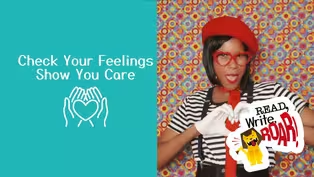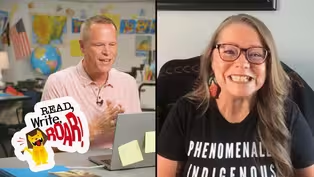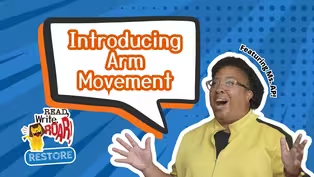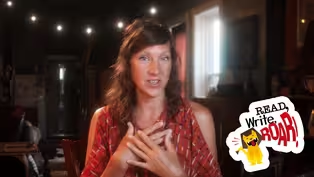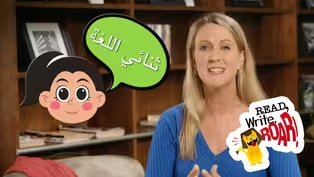Read, Write, ROAR!
Developing Characters & Plot! | Ms. Meg | Read, Write, ROAR!
Clip: Season 1 Episode 1006 | 4m 5sVideo has Closed Captions
Miss Meg explores how dialogue shapes characters, setting, and plot.
Dialogue is more than just characters talking—it's the key to developing your story! Miss Meg explores how dialogue shapes characters, setting, and plot. Learn how to create captivating conversations that keep readers hooked while revealing important details in your story.
Problems playing video? | Closed Captioning Feedback
Problems playing video? | Closed Captioning Feedback
Read, Write, ROAR! is a local public television program presented by Detroit PBS
Read, Write, ROAR!
Developing Characters & Plot! | Ms. Meg | Read, Write, ROAR!
Clip: Season 1 Episode 1006 | 4m 5sVideo has Closed Captions
Dialogue is more than just characters talking—it's the key to developing your story! Miss Meg explores how dialogue shapes characters, setting, and plot. Learn how to create captivating conversations that keep readers hooked while revealing important details in your story.
Problems playing video? | Closed Captioning Feedback
How to Watch Read, Write, ROAR!
Read, Write, ROAR! is available to stream on pbs.org and the free PBS App, available on iPhone, Apple TV, Android TV, Android smartphones, Amazon Fire TV, Amazon Fire Tablet, Roku, Samsung Smart TV, and Vizio.
Providing Support for PBS.org
Learn Moreabout PBS online sponsorship[Music] hey it's Miss Meg today we're going to learn how to talk to each other well we're actually going to learn how writer strategically use dialogue to help us learn more about characters keep a reader attention and much more we're going to break down the basics of dialogue and learn why it makes all of our favorite stories so great fun fact the word dialogue is Greek Dia means through and logos means word so through dialogue where it's said by characters in a story we can learn more about the three important story elements characters characters are a person or animal that lead us through the story setting the setting of The Story helps us identify where and when the story takes place and help shape the experiences the characters have plot flot is the sequence of events that makes the story's narrative think of it as the glue that holds the story together dialogue dialogue is also a creative way to make use of our figurative language skills similes and metaphors make dialogue come to life and that means our characters and stories also come to life so you won't be a fish out of water when it comes to dialogue let's dive in let's take a look at the dialogue from a Great Lakes Odyssey with Louis and Louise by Steven T shr at the beginning of chapter 2 Louis and Louise meet a group of minnows as they look for their friend snap we're looking for SNAP began Louis can you help us hearing snap's name the frightened minnows responded snap lizard on the next Bend be very careful thank you says Louise wondering why the minnows appeared scared let's dive even deeper dialogue isn't just what the sentences are saying if the text that surrounds the dialogue what comes before it what after it sometimes even what comes in the middle of it hearing snap's name the frightened minnows responded leou and Louise can tell that the minnows are scared not only does the narration with the adjective frighten help us understand that they are scared but the minnow dialogue supports the idea that they are scared but what would help us know that they are scared yes be very careful all right now let's test our skills and see if you can point out the different story elements from my writing titled day trips around Michigan let's read later that night after returning home from the Detroit Zoo mom asks hey Meg what was your favorite animal at the zoo I liked the Lions best Meg tells her thinking about the trip they just took can you identify the character setting and an event from the plot of my writing that's right the characters are Mom and mag the setting is home at night and the plot is their trip to the Detroit Zoo nice job finding those story [Music] elements we also know that it's after the trip we learned that Meg like the lion best and that Meg is thinking about their trip without saying it out loud so that's where the narration helps great job guys you really are becoming Pros today we learned about dialogue and how it helps us know more about the story elements of character setting and plot dialogue also helps us and the characters know what's going on and moves the story forward read at home with someone and show them how you understand a story by looking at the dialogue and the narration with it that was such great fun I can't wait for our next lesson done [Music]
Cultural Awareness in Michigan: Respect & Inclusivity Explained
Video has Closed Captions
Clip: S1 Ep1006 | 4m 18s | Introduce the importance of cultural awareness through real-life examples. (4m 18s)
How Interviews Work | Mr. Peterson | Read, Write, ROAR!
Video has Closed Captions
Clip: S1 Ep1006 | 6m 52s | Join Mr. Peterson as he interviews an expert about Anishinaabemowin. (6m 52s)
Read, Write, ROAR! Restore - Introducing Arm Movement
Video has Closed Captions
Clip: S1 Ep1006 | 2m 22s | Join Ms. AP in this 2-minute movement snack that combines running in place with arm lifts. (2m 22s)
Storm Soundscape | Ms. Audra | Create the Sounds of Nature
Video has Closed Captions
Clip: S1 Ep1006 | 2m 15s | Use your breath and body movements to recreate the excitement of a storm. (2m 15s)
Telling Intergenerational Stories | Mrs. DeFauw | Read, Write, ROAR!
Video has Closed Captions
Clip: S1 Ep1006 | 5m 45s | Learn how to preserve and share family stories for generations to come. (5m 45s)
Providing Support for PBS.org
Learn Moreabout PBS online sponsorship

- Home and How To

Hit the road in a classic car for a tour through Great Britain with two antiques experts.












Support for PBS provided by:
Read, Write, ROAR! is a local public television program presented by Detroit PBS
